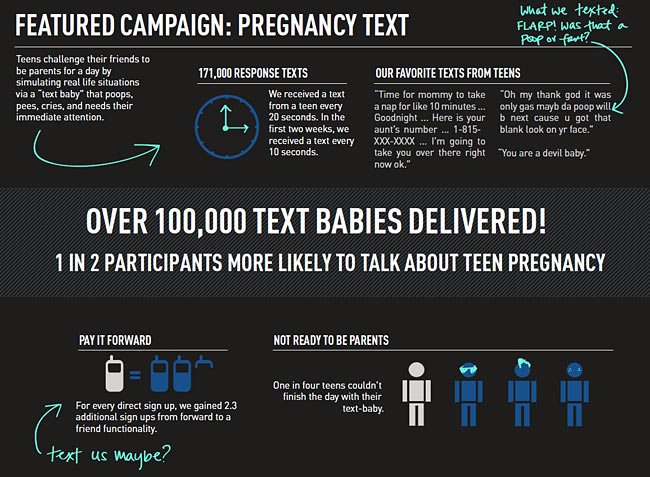Sometimes impact can be achieved without money, an adult or a car
This post was written by Beth Kanter, co-author of the new book Measuring the Networked Nonprofit: Using Data to Change the World. She and co-author KD Paine appear at TechSoup headquarters, 525 Brannan St., Suite 300 in San Francisco on Wednesday from noon to 1:30 p.m. Register to attend the free talk.
Target audience: Nonprofits, cause organizations, foundations, NGOs, social enterprises, businesses, educators, Web publishers, general public.
Guest post by Beth Kanter
beth’s blog
The New York-based nonprofit DoSomething.org has a big social change goal: To harness the energy of young people 25 and under and unleash it through national campaigns on causes teens care about. The call to action is always something that has a real impact and does not require money, an adult, or a car. Their measurable goal is to get 5 million active teen members engaged in social change campaigns by 2015. They use social media, mobile, and data to reach that goal.
A recent example is their “Pregnancy Text” campaign featured on their quarterly dashboard. This clever sex education campaign is an updated version of the teen pregnancy education program where young people carried eggs around and pretended they were babies. It was a text campaign where teens opted-in to receive texts on their mobile phones from the “baby.” Once they joined (and they could share it with their friends), they received regular annoying text messages at all hours from the “baby” that poops, cries, and needs their immediate attention.
The team at DoSomething.org uses data to determine the program design, key performance indicators, and a hypothesis to be tested.
They looked at survey data from the National Campaign: 87 percent of young people surveyed said it would be much easier for teens to delay sexual activity and avoid teen pregnancy if they were able to have more open, honest conversations about these topics with their parents and/or friends. So, success of this campaign would mean that participants talk with their family or friends about the issue and delay sexual activity.
Text messages as a powerful platform for social change
The basic design had those who signed up challenge their friends to take care of a text baby. They could either:
- Go to the DoSomething website and select five friends to challenge, or
- Challenge friends after reading a quick stat on US teen pregnancy sent via text from DoSomething to its 300,000 mobile subscribers.
Participants who accepted the challenge would then start receiving texts the following morning from the text baby. After completing the challenge, participants were prompted to send it to their own friends. DoSomething also followed up with 5,000 of the users with a text-based survey to measure impact.
Once they defined their goals and identified the right data collect, here are some of the insights they gleaned, according to Nancy Lublin, CEO, and Jeffrey Bladt, chief data scientist:
- SMS as a platform: In monitoring engagement per communication channel, they determined that SMS (text messaging) was be 30 times more powerful for getting their users to take action as compared to email.
- Challenging five friends: They tested various group sizes for SMS experience and have found the a group of six (one “alpha” inviting friends) leads to the highest overall engagement.
- Research-based messaging: The general messaging for the campaign was based on survey findings that found
- Big scare tactics — for example, getting pregnant equals not going to college — were not as effective as highlighting how being a teen parent changes daily life (for example, can’t go to the movies because the babysitter canceled)
- A report by the Centers for Disease Control found, “The impact of strong pregnancy prevention messages directed to teenagers has been credited with the [recent] teen birth rates decline.”
- A/B testing: DoSomething pre-tested different messages and frequency of sending the messages to smaller test groups of teens to optimize the number of messages the baby would send during the day, as well as the content. They ended up doubling the frequency and rewording several interactions as well as building in a response system (so the baby would respond if the teen texted an unsolicited response). The insights from these tests pushed up engagement and likelihood of forwarding at the end.
- Impact: They did a survey to measure this. One in two teens said participating in the Pregnancy Text campaign made it more likely they would talk about the issue of teen pregnancy with their family and friends.
As you can see from the above insights, DoSomething does more than gather and analyze topline data:
- 101,444 people took part in the campaign with 100,000 text babies delivered.
- There were 171,000 unsolicited incoming messages, or one every 20 seconds for the duration of the campaign. During the initial launch period (the first two weeks), a new text message was received every 10 seconds.
- For every one direct sign-up, DoSomething gained 2.3 additional sign-ups from forward-to-a-friend functionality. The viral coefficient was between 0.60 and 0.70 for the campaign.
- One in four (24%) of teens could not finish a day with their text baby (texted a stop word to the baby).
I heard Todd Park, Chief Technology Officer at the White House, say this about Big Data at the Mashable Social Good Summit: “Data by itself is useless. I can’t feed my baby daughter data, as much as I’d love to because I love data. It’s only useful if you apply it to create an actual public benefit.”
You can’t do that unless identify your results, collect the right data, and generate insights.
How is your nonprofit using data to change the world? Share in the comments below.
 This work is licensed under a Creative Commons Attribution 3.0 Unported.
This work is licensed under a Creative Commons Attribution 3.0 Unported.









